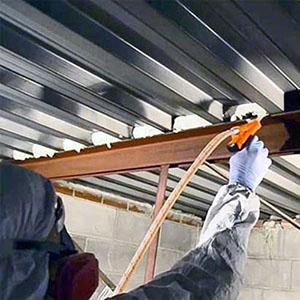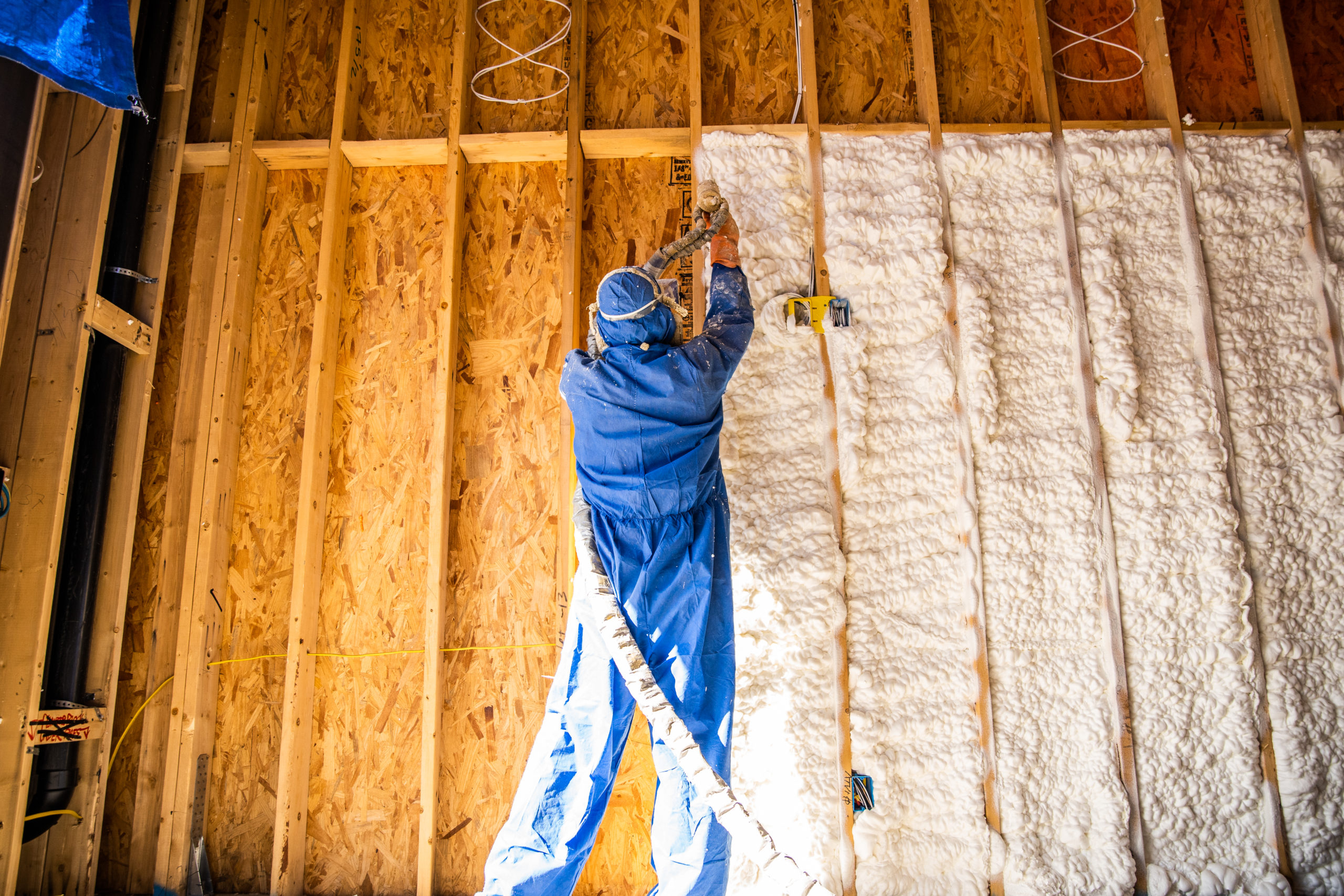Understanding the Benefits of Using Spray Foam for Insulation Projects
Understanding the Benefits of Using Spray Foam for Insulation Projects
Blog Article
Spray Foam: The Ultimate Solution for Air Sealing and Insulation
Spray foam insulation has emerged as a leading remedy for reliable air securing and thermal insulation, providing a distinct combination of homes that set it apart from traditional approaches. Recognizing the full range of its benefits, installation procedures, and contrasts with other insulation kinds is critical for making notified decisions.
What Is Spray Foam?
Spray foam is a functional insulation product that combines the concepts of air sealing and thermal resistance to enhance power effectiveness in structures. Made up primarily of polyurethane or other similar substances, spray foam is applied as a liquid that broadens upon contact with surface areas, producing a strong, constant layer of insulation. This unique residential or commercial property permits it to fill up gaps, fractures, and voids that typical insulation materials might neglect, giving a remarkable air seal.
There are two major sorts of spray foam: open-cell and closed-cell. Open-cell spray foam is lighter and a lot more flexible, using outstanding audio absorption and a lower R-value per inch - Spray Foam. On the other hand, closed-cell spray foam is denser, providing a higher R-value, dampness resistance, and added architectural integrity to developing parts
The application process commonly involves specific equipment, ensuring a smooth application that complies with various substratums, consisting of timber, concrete, and steel. This adaptability makes spray foam appropriate for both brand-new building and constructions and retrofitting existing structures. Its capability to produce an airtight barrier substantially adds to reducing energy usage and enhancing interior air top quality, thereby making it a preferred option amongst builders and property owners alike.
Advantages of Spray Foam Insulation
Among the most significant advantages of spray foam insulation is its phenomenal capacity to develop a continuous air barrier, which effectively reduces energy loss. Unlike conventional insulation materials, spray foam expands to fill gaps and cracks, ensuring that air leak is significantly decreased. This characteristic not just enhances power performance however likewise brings about lower energy expenses in time.
In addition, spray foam insulation offers premium thermal resistance, contributing to a more secure indoor atmosphere. Its high R-value per inch permits efficient insulation in restricted rooms, making it suitable for attic rooms, walls, and crawl spaces. In addition, the moisture-resistant homes of spray foam help protect against mold and mildew and mildew development, advertising healthier living problems.
One more critical advantage of spray foam insulation is its sound-dampening qualities (Spray Foam). It properly minimizes noise transmission in between rooms, producing a quieter and more comfy home environment. The longevity of spray foam likewise stands out, as it does not sag or work out over time, preserving its efficiency throughout its life expectancy
Just How Spray Foam Works
Recognizing how spray foam insulation functions is essential for appreciating its performance in air sealing and thermal resistance. Spray foam insulation is composed of two main parts: isocyanate and polyol resin. When these elements are combined, they undergo a chain reaction that creates the material to broaden swiftly, creating a dense foam that fills up voids, cavities, and fractures.
As the foam broadens, it sticks to surface areas, creating an airtight seal that considerably minimizes air seepage. This particular makes spray foam insulation highly effective at visit homepage avoiding drafts and wetness infiltration, which can cause power loss and damages with time. Additionally, the closed-cell variant of spray foam offers exceptional thermal resistance as a result of its inflexible framework, efficiently reducing heat transfer.
The special properties of spray foam allow it to satisfy irregular surfaces, ensuring comprehensive coverage and a seamless obstacle. Because of this, spray foam insulation not just improves energy efficiency but also adds to boosted interior air high quality by decreasing the accumulation of toxins and allergens. Ultimately, understanding the technicians behind spray foam emphasizes its function as an exceptional choice for insulation and air securing in both property and industrial applications.
Setup Refine Introduction

Before installation, the area has to be sufficiently cleansed and prepped, ensuring that surfaces are complimentary from wetness, dirt, and particles. Since pollutants can jeopardize bond and total efficiency, this action is crucial. Once the area is prepared, the application involves mixing both components of the spray foam, which expands upon contact and fills gaps effectively.
Trained professionals should conduct the installation, utilizing specialized tools to make certain consistent insurance coverage and optimum thickness. Security safety measures, including wearing safety equipment and making certain correct air flow, are imperative throughout this procedure. After application, the foam normally remedies rapidly, forming a strong obstacle that improves energy performance.
Contrasting Spray Foam to Standard Insulation
When reviewing insulation choices, spray foam insulation stands out in comparison to standard materials such as fiberglass and cellulose. Unlike fiberglass and cellulose, which can enable air infiltration, spray foam broadens upon application, filling spaces and crevices to produce an airtight seal.
Furthermore, spray foam provides a higher R-value per inch than typical insulation types, using more efficient thermal resistance in a thinner account. This characteristic is specifically advantageous in rooms with limited tooth cavity depth. Additionally, spray foam is immune to dampness and mold development, which can be a significant worry with cellulose and fiberglass, particularly in damp settings.
However, spray foam insulation usually lugs a greater upfront expense than its standard equivalents. Homeowners should evaluate this preliminary financial investment versus lasting power savings and performance benefits. Ultimately, while both insulation types serve their function, spray foam arises as an advanced remedy for modern-day insulation demands, particularly in terms of air securing and thermal efficiency.

Verdict
In recap, spray foam insulation represents an extremely efficient service for achieving optimum air securing and thermal resistance. Its special buildings, consisting of wetness resistance and noise dampening, make it suitable for numerous applications in both brand-new buildings and retrofitting projects (Spray Foam). The initial expenses might be higher contrasted to traditional insulation products, the long-term advantages, such as considerable power financial savings and improved interior air top quality, justify the investment and underscore its worth in contemporary structure techniques.
Spray foam insulation has click now actually emerged as a leading option for effective air securing and thermal insulation, using a distinct mix of residential properties that establish it apart read more from standard techniques.Spray foam is a functional insulation material that combines the concepts of air sealing and thermal resistance to improve power effectiveness in buildings.When assessing insulation alternatives, spray foam insulation stands out in comparison to standard materials such as fiberglass and cellulose. Eventually, while both insulation kinds serve their function, spray foam arises as a more sophisticated remedy for modern insulation requirements, particularly in terms of air sealing and thermal effectiveness.
In recap, spray foam insulation represents an extremely reliable solution for achieving ideal air securing and thermal resistance.
Report this page